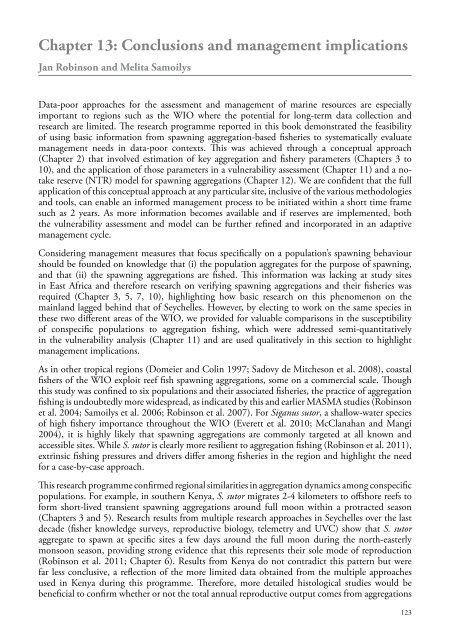WIOMSA-CORDIO spawning book Full Doc 10 oct 13.pdf
WIOMSA-CORDIO spawning book Full Doc 10 oct 13.pdf
WIOMSA-CORDIO spawning book Full Doc 10 oct 13.pdf
You also want an ePaper? Increase the reach of your titles
YUMPU automatically turns print PDFs into web optimized ePapers that Google loves.
Chapter 13: Conclusions and management implicationsJan Robinson and Melita SamoilysData-poor approaches for the assessment and management of marine resources are especiallyimportant to regions such as the WIO where the potential for long-term data collection andresearch are limited. The research programme reported in this <strong>book</strong> demonstrated the feasibilityof using basic information from <strong>spawning</strong> aggregation-based fisheries to systematically evaluatemanagement needs in data-poor contexts. This was achieved through a conceptual approach(Chapter 2) that involved estimation of key aggregation and fishery parameters (Chapters 3 to<strong>10</strong>), and the application of those parameters in a vulnerability assessment (Chapter 11) and a notakereserve (NTR) model for <strong>spawning</strong> aggregations (Chapter 12). We are confident that the fullapplication of this conceptual approach at any particular site, inclusive of the various methodologiesand tools, can enable an informed management process to be initiated within a short time framesuch as 2 years. As more information becomes available and if reserves are implemented, boththe vulnerability assessment and model can be further refined and incorporated in an adaptivemanagement cycle.Considering management measures that focus specifically on a population’s <strong>spawning</strong> behaviourshould be founded on knowledge that (i) the population aggregates for the purpose of <strong>spawning</strong>,and that (ii) the <strong>spawning</strong> aggregations are fished. This information was lacking at study sitesin East Africa and therefore research on verifying <strong>spawning</strong> aggregations and their fisheries wasrequired (Chapter 3, 5, 7, <strong>10</strong>), highlighting how basic research on this phenomenon on themainland lagged behind that of Seychelles. However, by electing to work on the same species inthese two different areas of the WIO, we provided for valuable comparisons in the susceptibilityof conspecific populations to aggregation fishing, which were addressed semi-quantitativelyin the vulnerability analysis (Chapter 11) and are used qualitatively in this section to highlightmanagement implications.As in other tropical regions (Domeier and Colin 1997; Sadovy de Mitcheson et al. 2008), coastalfishers of the WIO exploit reef fish <strong>spawning</strong> aggregations, some on a commercial scale. Thoughthis study was confined to six populations and their associated fisheries, the practice of aggregationfishing is undoubtedly more widespread, as indicated by this and earlier MASMA studies (Robinsonet al. 2004; Samoilys et al. 2006; Robinson et al. 2007). For Siganus sutor, a shallow-water speciesof high fishery importance throughout the WIO (Everett et al. 20<strong>10</strong>; McClanahan and Mangi2004), it is highly likely that <strong>spawning</strong> aggregations are commonly targeted at all known andaccessible sites. While S. sutor is clearly more resilient to aggregation fishing (Robinson et al. 2011),extrinsic fishing pressures and drivers differ among fisheries in the region and highlight the needfor a case-by-case approach.This research programme confirmed regional similarities in aggregation dynamics among conspecificpopulations. For example, in southern Kenya, S. sutor migrates 2-4 kilometers to offshore reefs toform short-lived transient <strong>spawning</strong> aggregations around full moon within a protracted season(Chapters 3 and 5). Research results from multiple research approaches in Seychelles over the lastdecade (fisher knowledge surveys, reproductive biology, telemetry and UVC) show that S. sutoraggregate to spawn at specific sites a few days around the full moon during the north-easterlymonsoon season, providing strong evidence that this represents their sole mode of reproduction(Robinson et al. 2011; Chapter 6). Results from Kenya do not contradict this pattern but werefar less conclusive, a reflection of the more limited data obtained from the multiple approachesused in Kenya during this programme. Therefore, more detailed histological studies would bebeneficial to confirm whether or not the total annual reproductive output comes from aggregations123


















